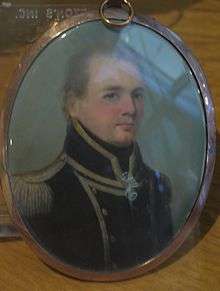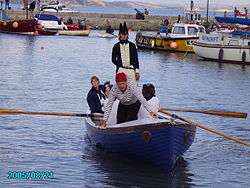John Richards Lapenotière
Captain John Richards Lapenotière (1770 – 19 January 1834) was a British Royal Navy officer who, as a lieutenant commanding the tiny topsail schooner HMS Pickle, observed the Battle of Trafalgar on 21 October 1805, participated in the rescue operations which followed it and then carried the dispatches of the victory and the death of Admiral Nelson to Britain.
John Richards Lapenotière | |
|---|---|
 A Miniature believed to depict John Richards Lapenotière | |
| Born | 1770 Ilfracombe, Devon, England |
| Died | 19 January 1834 Roseland, near Menheniot, Cornwall |
| Allegiance | |
| Service/ | |
| Years of service | 1780 - 1811 |
| Rank | Post Captain |
| Battles/wars | Battle of Trafalgar, 1805 Battle of Copenhagen, 1807 |
Early life
Born in 1770 in Ilfracombe, Devon to a Huguenot exile family that came to Britain in 1688 with William of Orange, he came from a military family: His great grandfather, Frederick La Penotiere, served in the Royal Irish Regiment in the campaigns of the Duke of Marlborough in the War of the Spanish Succession and received a bounty for his service at the Battle of Blenheim, in 1704.
Service career
John followed his father, Frederick, into naval service, joining his father’s ship unofficially, at just ten years old. At fifteen he enlisted with Nathaniel Portlock on a commercial expedition to what is now Alaska and the Canadian Pacific coast (then a bare and savage coast), where he learned the principles of seamanship in difficult climates and the handling of small ships, which was very advantageous to him, given that he spent most of his career in such craft. After a period of service as a midshipman in the Royal Navy, Lapenotière again took a leave of absence, to accompany Portlock and William Bligh on a breadfruit expedition to the South Pacific, to replace those plants lost following the Mutiny on the Bounty.
Returning in time for service in the French Revolutionary War, Lapenotière travelled to the West Indies in the fleet under John Jervis in HMS Margarita, being briefly appointed lieutenant into HMS Boyne before his superior knowledge of seamanship earned him a temporary independent command in the schooner HMS Berbice. In 1796 he was transferred into the frigate HMS Resource and from there into four other ships, each of them without event or action. By 1800, he had yet to spend a full year in any ship but was given the small cutter Joseph, as a reward for his patience. In Joseph he distinguished himself in small boat actions on the French coast prior to the Peace of Amiens. At the peace he found himself on the beach for the first long stretch of time since 1779. During this period ashore, he married Lucia Shean, with whom he had three daughters.

His efforts had not gone unnoticed, however and in 1802 he was given the 10 gun schooner HMS Pickle, in which he again cruised the French coast. He earned accolades in 1804 for saving the crew of the ship of the line HMS Magnificent, which was wrecked off Ushant. He was widowed during this period but soon remarried to Mary Anne Graves and had a further seven children, two of whom later became naval officers themselves. He was subsequently attached to Nelson’s fleet blockading Cadiz, helping to feed the fleet by capturing Spanish and Portuguese livestock and grain transports.
Battle of Trafalgar
Pickle was much too small to serve an active role in the Battle of Trafalgar, which culminated the campaign on 21 October 1805 but her assistance was invaluable during the difficult and dangerous task which arose during the ensuing storm. Lapenotière’s ship was engaged in rescuing survivors from the water, taking men off sinking ships over the next week and even towing damaged hulks in an effort to rescue them from the waves. On 26 October, Admiral Collingwood sent Pickle to Britain with the dispatches telling of the great victory. This was a signal honour for any junior officer, since it almost guaranteed promotion and fame and some of the other junior officers later expressed anger at the seeming preferment of Lapenotière.

Arriving in the English Channel on 1 November, Lapenotière realised that the wind was so strong it would prevent him from making landfall further up the Channel and so landed at Falmouth. He then took an exhausting series of mail coaches and horses overland to London, where he arrived on 6 November, after a journey of about 271 miles and involving 21 changes of horses taking 37 hours and costing £46 [each stage being between 10 and 15 miles at a speed of just over 7 mph] , to give his despatches to William Marsden, First Secretary to the Board of Admiralty, with the simple words, “Sir, we have gained a great victory. But we have lost Lord Nelson.”[Note 1] As was expected, Lapenotière was greatly rewarded for his feat. He received promotion to Commander, a sword from the Lloyd's Patriotic Fund, and £500 in cash. King George III gave him a silver spice sprinkler, which the mayor's office in Liskeard now owns. He was subsequently given the command of the 16-gun Orestes and participated in the bombardment of Copenhagen in 1807, where he was badly wounded by an exploding gun.
His next four years of sea service was spent sailing the Orestes out of Plymouth. With Orestes he took two privateers (one French, one American), and a rich American merchant ship.
In 1811, he received promotion to Post Captain but was unable to secure a ship and spent the remainder of the war on shore duties. He never captained a ship again, settling in Menheniot near Liskeard, in Cornwall with his family, dying peacefully in 1834. He was buried next to his second wife in the churchyard at Menheniot.
See also
- Trafalgar Way
Footnotes
- In 1974 the Royal Navy commenced the tradition of annual Pickle Night dinners in many a Royal Navy Senior Rates Mess to commemorate Lapenotière's return with the news of Trafalgar and Nelson.
Further reading
- The Trafalgar Captains, Colin White and the 1805 Club, Chatham Publishing, London, 2005, ISBN 1-86176-247-X
- Lieutenant Lapenotière, a short story by Arthur Quiller-Couch at gutenberg.org